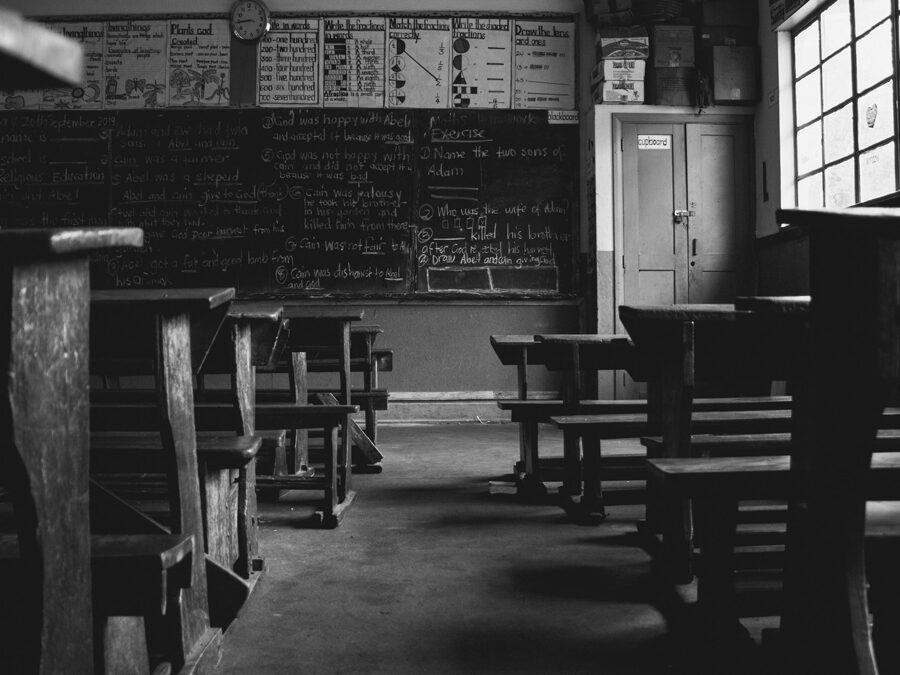
by DeMisty Bellinger | Apr 17, 2020 | micro
The telephone poles looked like crucifixes. I had the time to contemplate them, and that was how silent it was. We all remained inside like the person on the radio demanded us to. We looked out the large window, having pushed aside displays of shelved books and tea sets to see the large, male tiger, his testicles hanging noticeably from his crotch. From inside, we could hear the half growling, half purring noise he made. We probably more felt it than heard it. It was low. He paced.
“How long will he stay out there?” someone behind me said. I recognized the voice, but I had a hard time placing a disembodied voice to the person. I always had. I had a hard time understanding what was said without looking at the person who spoke. “Why hasn’t,” a woman asked, “anyone come to get him yet?” I went through the schedule in my head and remembered that Julie was the only other woman besides me working the floor that day. What I could think of to answer was that not all our days can be tiger free. After I had said it, I backed away from the window. Someone arrived in an armored car marked “zoo.” And also: some cop cars. An animal control van. I could hear the report from the tranquilizer gun. I thought of those savior-less telephone poles, the wires going to everywhere.
Originally published in WhiskeyPaper
Photo by Sacha Styles on Unsplash

by Stuart Dybek | Apr 17, 2020 | micro
In summer, waiting for night, we’d pose against the afterglow on corners, watching traffic cruise through the neighborhood. Sometimes, a car would go by without its headlights on and we’d all yell, “Lights!”
“Lights!” we’d keep yelling until the beams flashed on. It was usually immediate—the driver honking back thanks, or flinching embarrassed behind the steering wheel, or gunning past, and we’d see his red taillights blink on.
But there were times—who knows why?—when drunk or high, stubborn, or simply lost in that glide to somewhere else, the driver just kept driving in the dark, and all down the block we’d hear yelling from doorways and storefronts, front steps, and other corners, voices winking on like fireflies: “Lights! Your lights! Hey, lights!”
Originally published in The Coast of Chicago
Photo by Carson Masterson on Unsplash

by Tara Laskowski | Apr 17, 2020 | micro
It was 10th grade, the year of Hurricane Isaac, which mowed down the mighty oak in the teacher’s parking lot, snapped it like a cinnamon stick and prompted Mr. Luckanza to teach us about dendrochronology, counting the tree’s rings. Grown-ups wanted to turn everything into a lesson.
It was the year the football team had a shot, and they introduced cheese fries into the cafeteria. We had to take English 10 and read dog-eared copies of “How Green Was My Valley?”, which everyone kept calling “How Long Is My Valley?” The economy tanked and my mom took a second shift at the late night diner. We all turned 16 and some of us got parties. The biggest one was Shannon Richardson’s, talked about for months because someone vomited all over her parents’ white suede sofa and she posted flyers on certain lockers looking for a confession.
It was the year people started losing their virginity, whether on purpose or not. Then, right before Christmas break, they found Mr. Luckanza in his car with a pistol in his lap and a shattered windshield stained red the color of those poisonous berries our parents always warned us not to eat. In the spring, a group of men came in overalls to finally take the oak away, chain-sawing it in pieces and tossing the hunks over the side of their pick-up. Even after they drove away I could still imagine rolling my fingers along the tree’s insides, the roughness of the bark and the tenderness of the inside, some rings small, some larger, some stained dark and hardened like a cancer, almost like it knew what was coming but couldn’t tell anyone until it was too late.
Originally published in The Northville Review and New Micro
Photo by AC TYLER on Unsplash

by Pamela Painter | Apr 17, 2020 | flash fiction
They don’t seem to be working, though up to a few minutes ago, she was filing papers. A man (whom we assume is her boss) sits reading a page at his desk, holding it beneath a green banker’s light. Her plump right arm is bent to encompass a generous bosom and her right hand rests on the edge of the open file drawer. Perhaps seconds ago she turned toward the man at the desk. Her face is vulnerable, intent. She is waiting. A piece of paper, partly hidden by the desk, lies on the floor between her and the man. We are led to believe that Edward Hopper is in a train, glimpsing this scene as he is passing by on Chicago’s El.
A voluptuous curve—perhaps the most voluptuous in all of Hopper’s paintings, almost to a surreal degree—belongs to this secretary in the night-blue dress in “Office at Night,” an oil on canvas, l940. What word, in 1940, would have been used to describe those rounded globes beneath the stretch, from rounded hip to hip, of her blue dress?
If it weren’t for that piece of paper on the floor, we might believe the museum’s prim description of this painting. It says: “The secretary’s exaggerated sexualized persona contrasts with the buttoned-up indifference of her boss; the frisson of their intimate overtime is undermined by a sense that the scene’s erotic expectations are not likely to be met.”
Indifference? Wrong. The man is far too intent on the paper he is reading—and he is not sitting head-on at his desk. He is somewhat tilted—toward the secretary. His mouth is slightly open as if to speak. His left ear is red. It is. It is red.
And what of their day? Her desk faces his in this small cramped office. He must have looked up from his papers to say to her, seated behind her black typewriter, that tonight they must stay late. Did she call her mother, or two roommates she met while attending Katherine Gibbs, to say her boss asked her to stay late? On other evenings, she would have finished dinner, perhaps been mending her stockings or watching the newsreel at the cinema’s double feature.
But here she is tonight, looking down at the paper on the floor. Was it she who dropped it? It is true that her dress has a chaste white collar, but the deep V of the neckline will surely fall open when she stoops to retrieve it. Or did the man drop the paper? Is she acknowledging this before she stoops over, perhaps bending at the knees over her spiffy black pumps, to retrieve the page? Another paper has been nudged toward the desk’s edge and shows a refusal to lie flat in the slight breeze blowing the window shade into the office. Other papers are held in place by the 1940s telephone, so heavy that in a forties noir film it might serve as the murder weapon.
Perhaps this story began at an earlier time. It might already be a situation, causing the young woman, just this morning, to choose this particular blue dress. We are all in the middle of their drama. She will bend before him. Someone will turn off the lights. They will leave before midnight. Perhaps it won’t turn out well. But for now her blue dress cannot be ignored.
Originally published in Smokelong Quarterly
Photo by Kamil Feczko on Unsplash

by W. Todd Kaneko | Apr 17, 2020 | micro
From the rear wall, Metalhead looks at the back of a girl’s head in History class. She is the only black girl in class and always sits in front, right next to the American flag. They are learning about Civil Rights, how one man had a dream and taught America about the content of a person’s character. Metalhead thinks about how he hasn’t said the Pledge of Allegiance since second grade—he just mouths the words to a song he once sang with his father on a car trip to Saginaw about dragons and smoking grass. After class, Metalhead will eat a slice of pizza and get high in the back parking lot. After school, his father won’t discuss layoffs at the auto plant, and when the family moves to a more remote suburb, there will be no conversation about white flight or a neighborhood’s changing hues as it breaks and corrodes. He won’t ask why his friends play air guitar along with Eddie Van Halen and Jimmy Page but never Jimi Hendrix because one day he will sell used cars and a woman he remembers from high school will ask to take a rickety Ford Tempo for a test drive. He won’t remember her name, but will recall how she once looked at him that way a child looks at an injured animal before learning that people aren’t supposed to reveal how they feel inside. He won’t let her drive the Tempo, guiding her to a car with a sturdier axle, a truthful odometer. This will happen decades after that girl in the front row looks back at the clock ticking over Metalhead’s desk. Her eyes fall on him for a moment before she turns back around. Metalhead places his hand on his heart and discovers it still beating.
Originally published by New South: A Journal of Art &Literature
Photo by Rubén Rodriguez on Unsplash






Recent Comments